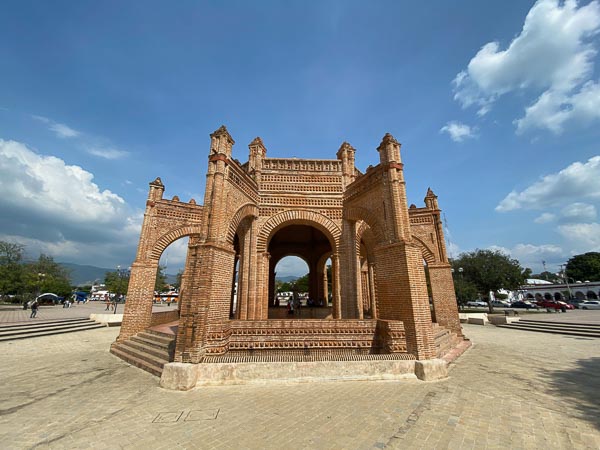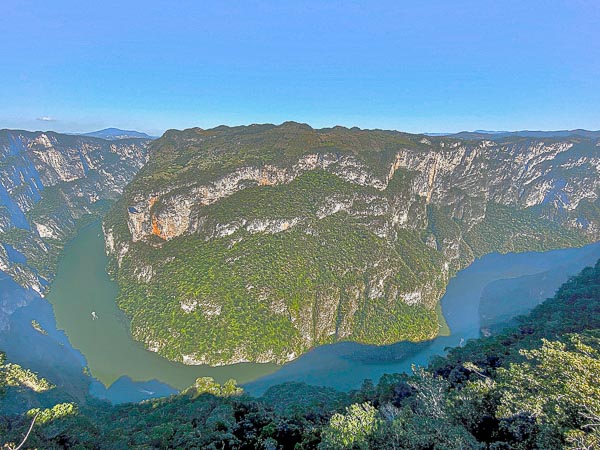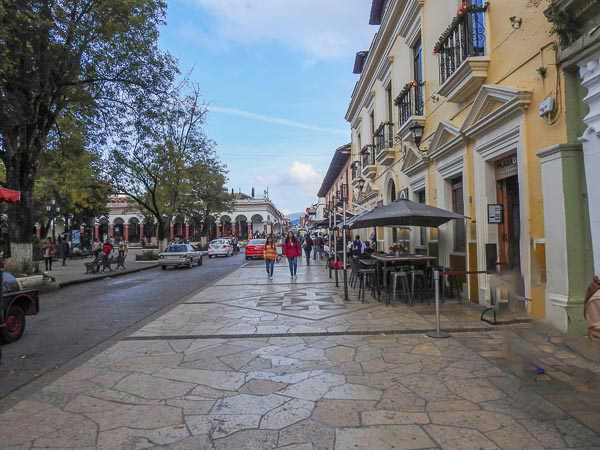Chiapas, situated in southeastern Mexico bordering Guatemala, boasts a remarkable geographical tapestry. Occupying the eighth-largest position among Mexican states, its 74,415 km² encompass a fascinating array of ecosystems.
A Realm Shaped by Altitude
 Climate in Chiapas is intricately linked to elevation. Warm temperatures dominate areas below 1,000 meters, transitioning to semi-warm climates between 1,000 and 2,000 meters. Above 2,000 meters, temperate climates prevail, with the peak of Tacaná Volcano experiencing a genuinely cold environment. The state is also marked by a pronounced rainy season, fostering regions with significant summer rainfall. Notably, Chiapas holds the distinction of harboring Mexico’s two zones of maximum precipitation, receiving over 4,000 mm annually in the Soconusco coffee highlands and the northern mountains.
Climate in Chiapas is intricately linked to elevation. Warm temperatures dominate areas below 1,000 meters, transitioning to semi-warm climates between 1,000 and 2,000 meters. Above 2,000 meters, temperate climates prevail, with the peak of Tacaná Volcano experiencing a genuinely cold environment. The state is also marked by a pronounced rainy season, fostering regions with significant summer rainfall. Notably, Chiapas holds the distinction of harboring Mexico’s two zones of maximum precipitation, receiving over 4,000 mm annually in the Soconusco coffee highlands and the northern mountains.
A Mosaic of Physiographic Regions
 Chiapas is a land of captivating contrasts, further accentuated by its seven distinct physiographic regions. These regions encompass the Pacific Coastal Plain, the Sierra Madre de Chiapas, the Central Depression, the Highlands, the Eastern Sierra, the Northern Sierra, and the Gulf Plain.
Chiapas is a land of captivating contrasts, further accentuated by its seven distinct physiographic regions. These regions encompass the Pacific Coastal Plain, the Sierra Madre de Chiapas, the Central Depression, the Highlands, the Eastern Sierra, the Northern Sierra, and the Gulf Plain.
Chiapas mountainous region, characterized by a complex geological history, exhibits a remarkable diversity of landforms, climates, vegetation zones, and fauna. Ranging from warm to cold and very humid to semi-arid, it encompasses everything from low, medium, and high jungles to cloud forests, pine, and oak woodlands. This sierra connects with the Central American volcanic chain, where the majestic Tacaná Volcano resides. The cloud forest ecosystem flourishes in the El Triunfo Reserve, providing a haven for species like the resplendent quetzal and the pavón.
Chiapas is also a coastline. This region runs parallel to the ocean, traversed by short, fast-flowing rivers that culminate in estuaries and coastal lagoons during the rainy season. The Suchiate River stands out as the largest among them.
 Impressionably, some regions in Chiapas are beautiful valleys like the “El Cañon del Sumidero”. This valley, sculpted by the upper Grijalva River, features adjacent valleys nestled between the bordering mountain formations. Its low altitude translates to a warm and semi-dry climate, with natural vegetation comprising low deciduous jungle, savannas, palm groves, and gallery forests alongside the rivers. Notably, Tuxtla Gutiérrez, the state’s most populous urban center, is situated within this region.
Impressionably, some regions in Chiapas are beautiful valleys like the “El Cañon del Sumidero”. This valley, sculpted by the upper Grijalva River, features adjacent valleys nestled between the bordering mountain formations. Its low altitude translates to a warm and semi-dry climate, with natural vegetation comprising low deciduous jungle, savannas, palm groves, and gallery forests alongside the rivers. Notably, Tuxtla Gutiérrez, the state’s most populous urban center, is situated within this region.
Chiapas is also know for its region “Los Altos de Chiapas!. These central, elevated mountains boast temperate forest associations. Two
distinct landscapes grace this region: the central highlands, exemplified by the Jovel Valley where San Cristóbal de Las Casas rests, and the high plains zone to the southeast, encompassing the Montebello Lakes. The awe-inspiring Sumidero Canyon carves dramatically through the western section of the highlands.
 More mountains… Often referred to as “Cañadas,” these mountains comprise a series of ranges oriented northwest-southeast. Valleys sculpted by mighty tributaries of the Usumacinta River and karstic lakes like Miramar, Ojos Azules, Nahá, and El Suspiro separate these ranges.
More mountains… Often referred to as “Cañadas,” these mountains comprise a series of ranges oriented northwest-southeast. Valleys sculpted by mighty tributaries of the Usumacinta River and karstic lakes like Miramar, Ojos Azules, Nahá, and El Suspiro separate these ranges.
The warm, humid, and exceptionally rainy climate fosters the Lacandon Jungle, partially protected within the Montes Azules Biosphere Reserve. This area, teeming with fauna, serves as one of the last remaining sanctuaries for the jaguar and other mammals. Notably, this region also witnessed the rise of grand Classic Mayan cities like Yaxchilán and Bonampak.
The north region features an active volcanic zone, exemplified by the Chichón Volcano. Amber, a fossilized resin considered a Chiapas treasure, offers a glimpse into the geological past of these mount
ains. The diverse topography and extensive hydrological network have resulted in the formation of numerous waterfalls, including the renowned Agua Azul. Interestingly, the pre-Hispanic city of Palenque flourished on the slopes of these mountains.
Chiapas is s Destination Beckoning Exploration
Chiapas beckons visitors with a multitude of captivating destinations, eachoffering a unique window into its magnificent landscapes and rich cultural heritage. From verdant rainforests and cascading waterfalls to ancient Mayan ruins and vibrant cities,
Chiapas promises an unforgettable adventure for every explorer… Simply, A paradise to discover at every step.
Chiapas offers the visitor several destinations to know and explore its wonderful territory.




 Climate in Chiapas is intricately linked to elevation. Warm temperatures dominate areas below 1,000 meters, transitioning to semi-warm climates between 1,000 and 2,000 meters. Above 2,000 meters, temperate climates prevail, with the peak of Tacaná Volcano experiencing a genuinely cold environment. The state is also marked by a pronounced rainy season, fostering regions with significant summer rainfall. Notably, Chiapas holds the distinction of harboring Mexico’s two zones of maximum precipitation, receiving over 4,000 mm annually in the Soconusco coffee highlands and the northern mountains.
Climate in Chiapas is intricately linked to elevation. Warm temperatures dominate areas below 1,000 meters, transitioning to semi-warm climates between 1,000 and 2,000 meters. Above 2,000 meters, temperate climates prevail, with the peak of Tacaná Volcano experiencing a genuinely cold environment. The state is also marked by a pronounced rainy season, fostering regions with significant summer rainfall. Notably, Chiapas holds the distinction of harboring Mexico’s two zones of maximum precipitation, receiving over 4,000 mm annually in the Soconusco coffee highlands and the northern mountains. Chiapas is a land of captivating contrasts, further accentuated by its seven distinct physiographic regions. These regions encompass the Pacific Coastal Plain, the Sierra Madre de Chiapas, the Central Depression, the Highlands, the Eastern Sierra, the Northern Sierra, and the Gulf Plain.
Chiapas is a land of captivating contrasts, further accentuated by its seven distinct physiographic regions. These regions encompass the Pacific Coastal Plain, the Sierra Madre de Chiapas, the Central Depression, the Highlands, the Eastern Sierra, the Northern Sierra, and the Gulf Plain. Impressionably, some regions in Chiapas are beautiful valleys like the “El Cañon del Sumidero”. This valley, sculpted by the upper Grijalva River, features adjacent valleys nestled between the bordering mountain formations. Its low altitude translates to a warm and semi-dry climate, with natural vegetation comprising low deciduous jungle, savannas, palm groves, and gallery forests alongside the rivers. Notably, Tuxtla Gutiérrez, the state’s most populous urban center, is situated within this region.
Impressionably, some regions in Chiapas are beautiful valleys like the “El Cañon del Sumidero”. This valley, sculpted by the upper Grijalva River, features adjacent valleys nestled between the bordering mountain formations. Its low altitude translates to a warm and semi-dry climate, with natural vegetation comprising low deciduous jungle, savannas, palm groves, and gallery forests alongside the rivers. Notably, Tuxtla Gutiérrez, the state’s most populous urban center, is situated within this region. More mountains… Often referred to as “Cañadas,” these mountains comprise a series of ranges oriented northwest-southeast. Valleys sculpted by mighty tributaries of the Usumacinta River and karstic lakes like Miramar, Ojos Azules, Nahá, and El Suspiro separate these ranges.
More mountains… Often referred to as “Cañadas,” these mountains comprise a series of ranges oriented northwest-southeast. Valleys sculpted by mighty tributaries of the Usumacinta River and karstic lakes like Miramar, Ojos Azules, Nahá, and El Suspiro separate these ranges.